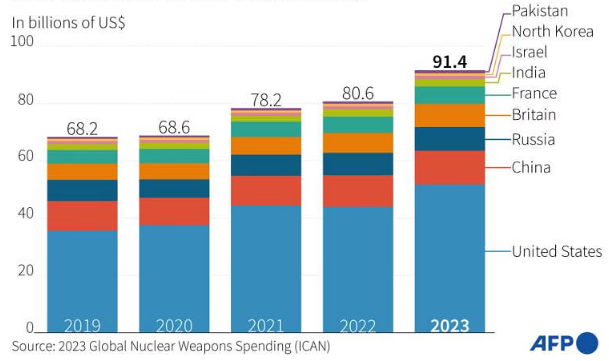
Nuclear-armed nations have increased their spending on atomic weapons by a third over the past five years to modernize their arsenals amid rising geopolitical tensions, according to two reports released on Monday.
Last year, the nine nuclear-armed countries collectively spent $91 billion on their arsenals, as detailed in a report by the International Campaign to Abolish Nuclear Weapons (ICAN). This, along with a separate report from the Stockholm International Peace Research Institute (SIPRI), indicates a significant uptick in nuclear weapons spending as countries modernize and deploy new nuclear arms.
Wilfred Wan, head of SIPRI’s weapons of mass destruction program, warned in a statement, “We have not seen nuclear weapons playing such a prominent role in international relations since the Cold War.”
SIPRI’s report noted a slight decline in the total estimated number of nuclear warheads globally, from 12,512 last year to 12,121 at the start of this year. However, it reported an increase in the number of operational warheads, with 9,585 in stockpiles ready for potential use, up by nine from the previous year, and 2,100 kept on “high operational alert” on ballistic missiles.
While the majority of these warheads are held by the United States and Russia, SIPRI indicated that China is now also believed to have some warheads on high operational alert for the first time.
“While the global total of nuclear warheads continues to fall as Cold War-era weapons are gradually dismantled, regrettably, we continue to see year-on-year increases in the number of operational nuclear warheads,” said SIPRI director Dan Smith.
The spending surge detailed in ICAN’s report corroborates this trend. In 2023 alone, global nuclear weapons spending increased by $10.8 billion compared to the previous year, with the United States contributing to 80 percent of that rise. The US spent $51.5 billion on nuclear arms, exceeding the combined total of all other nuclear-armed countries. China followed with $11.8 billion, and Russia with $8.3 billion.
Britain’s nuclear spending rose significantly for the second consecutive year, increasing by 17 percent to $8.1 billion. The nuclear-armed states, including France, India, Israel, Pakistan, and North Korea, collectively increased their spending by more than 33 percent from $68.2 billion in 2018, when ICAN first started collecting this data. Since then, these countries have spent an estimated total of $387 billion on nuclear weapons.
Parke criticized the expenditure as “a profound and unacceptable misallocation of public funds,” noting it exceeds the World Food Programme’s estimates for ending world hunger. She pointed out that the funds could also plant a million trees for every minute spent on nuclear weapons.
“These numbers are obscene,” she said, emphasizing that these investments are in weapons that are intended never to be used, as per the nuclear deterrence doctrine. She further warned of the extreme danger posed by these investments, asking, “What happens when deterrence fails?”
Geneva-based ICAN, which won the 2017 Nobel Peace Prize for its role in drafting the Treaty on the Prohibition of Nuclear Weapons (effective since 2021), urges the nuclear-armed states to join the treaty. Alicia Sanders-Zakre, co-author of the ICAN report, stated, “Instead of investing in Armageddon, the nine nuclear-armed states should follow the example of almost half the world’s countries and join the treaty to make a real contribution to global security.”
To date, seventy countries have ratified the treaty, with more having signed it, although none of the nuclear-armed states have joined.